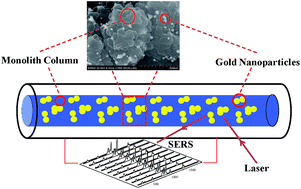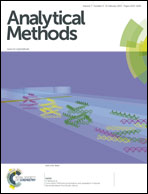Gold-nanoparticle, functionalized-porous-polymer monolith enclosed in capillary for on-column SERS detection
Abstract
In this work, gold-nanoparticle, functionalized glycidyl methacrylate-ethylene dimethacrylate (GNPs@GMA-EDMA), porous-polymer monoliths were prepared via an on-site synthesis method and enclosed in silica capillary as sensitive, uniform, and stable surface-enhanced Raman scattering (SERS) substrates. The on-column detection technique was used for SERS detection. The 4-mercaptopyridine (4-Mpy) at 1 × 10−7 M concentration was successfully detected on the SERS substrate. Uniformity was examined by collecting 4-Mpy spectra at 10 random locations on the capillary column, and the relative standard deviations (RSDs) were 18.74% and 15.83% for corresponding Raman intensities. The GNPs@GMA-EDMA showed great SERS-active stability in the first month after synthesis and could provide stable SERS signals of 4-Mpy within 8 months. The detection ability of this SERS-active monolith for pesticides, dyes and biomolecules was demonstrated by phosmet, crystal violet and adenine. Phosmet in real samples was analyzed by this substrate, with recovery of 89.78–109.91% and RSDs of 4.14–8.78%. The SERS-active porous polymer monoliths could serve as a novel SERS substrate for rapid in situ analysis on a capillary column.


 Please wait while we load your content...
Please wait while we load your content...